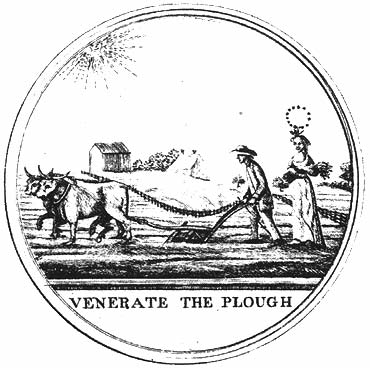The rudder, oar, or plow--all similarly shaped objects, usually to Fortuna's right hand side, often with Her right hand resting on the handle. This device shows Her ability to guide or steer, Her status as a conscious (not fickle or capricious) director of destiny. Each of these tools also "cuts" water or earth, stirring the cauldron of nature into productivity. Boats can indicate travel, and so are associated with spiritual journeys--through life, in the Shamanic sense, or beyond death. Boat associations connect Fortuna with Isis, who travelled in a papyrus canoe in search of the parts of God Osiris. Both Fortuna and Isis were associated with commerce and enjoyed navigation festivals blessing travel and commerce. As the rudder or oar cuts the sea to bring back abundance and weave the fabric of connection, so too does the plow cut the earth to bring forth plenty. The aperature that this cut represents is also in the primal cave of Fortuna Primigenia and the open vessel of the Horn of Plenty. It is Her yoni and portal. If we belong in Her train, we take on the role of sea or earth and cooperate with Her more conscious hand to come into our fullness. A key point to notice is the relationship of the tool to the elements and that they suggest an abundance coming from a way of life that is close to nature, maritime or agricultural. The shape of the object calls to mind the adze, a functional tool in many ancient societies and today, and one which took on important ritual significance symbolizing the powers of creation. It was used in rituals magically inuaugurating new projects or each new year. The invention of the adze made many of the basic tasks of civilization possible, including those of the wheelwright and shipbuilder. As a groundbreaking hoe or woodworking tool, the adze splits, cuts or iniates new things. It suggests a creative, functional use of division or duality weilded by the Goddess. But as with the oar in water or plow in earth, this division is not always destructive. The ancient Roman New Year was springtime, in March, as were "Venerate the Plough" graphic is from an early 19th century Virginia publication promoting the agrarian ideals of Thomas Jefferson. Here, Fortuna is Americanized in Her crown of thirteen stars, which also indicate the thirteen stations of the lunar Wheel that govern agriculture.

 festivals of Isis and Fortuna that blessed the annual commencement of navigation. So in one hand the Goddess grasps beginnings and in the other, harvests, and the Wheel of the Year turns on and on. See the entry on the nail as a symbol of Fortuna for even more New Year's associations.
festivals of Isis and Fortuna that blessed the annual commencement of navigation. So in one hand the Goddess grasps beginnings and in the other, harvests, and the Wheel of the Year turns on and on. See the entry on the nail as a symbol of Fortuna for even more New Year's associations.![]() In Egypt, the adze was used in the ritual of "Opening the Mouth," performed on a sacred image to invite Divine Life when it was installed in a temple, or on the sacred remains of the dead, at the end of the mummification process and just before entombment. The adze and pot, which call to mind rudder and cornucopia, form a hieroglyph for the phoneme nw or the word sotep, often used in compound royal names.
In Egypt, the adze was used in the ritual of "Opening the Mouth," performed on a sacred image to invite Divine Life when it was installed in a temple, or on the sacred remains of the dead, at the end of the mummification process and just before entombment. The adze and pot, which call to mind rudder and cornucopia, form a hieroglyph for the phoneme nw or the word sotep, often used in compound royal names.
